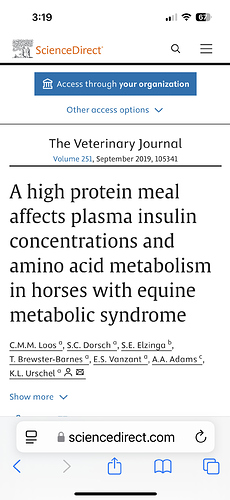Yet another vet who misses the bigger picture 
what if the forage is low protein and not meeting the horse’s very basic needs, let alone optimal needs?
1-2lb of 32% protein isn’t the problem, it’s 0.5-1.0 % of a 20lb-of-feed diet
As far as the study:
“Horses were fed 2 g/kg body mass (BM) of a high protein pellet (31% crude protein) at time 0 and 30 min, for a total of 4 g/kg BM, following an overnight fast.”
This means 2.2gm of the pellet, then another 2.2gm 30 minutes later, on a fasted stomach, with no fiber to slow things down through the digestive system. It’s an unfair study that’s not related to reality
https://www.sciencedirect.com/science/article/abs/pii/S1090023319300760
Is there some possibility that a high protein DIET - the whole diet, not just a meal - can be a problem for some IR/EMS horses? Yes. I don’t remember the details, but it has to do with how excess protein is metabolized with some of it - if there’s really an excessive amount, ending up converted to glucose
1lb of a 32% protein ration balancer isn’t going to do that, unless maybe there’s a whole lot of alfalfa in the diet, and at that point, the whole lot of alfalfa is the bigger issue
Edit for more numbers:
Let’s say the 1000-1100lb horse needs 700gm protein total for his weight and work.
Let’s say his hay is around 8% - good for some grasses, a bit low for some others, a reasonable average. 20lb of that is 726gm protein, so just meeting his basic needs. If it was 10% it would be 908gm
1lb of a 32% balancer is 145gm protein
That means the balancer protein is 13-16% of the total protein in the diet. And realistically, 908gm isn’t truly excessive for a requirement of at least 700gm.


